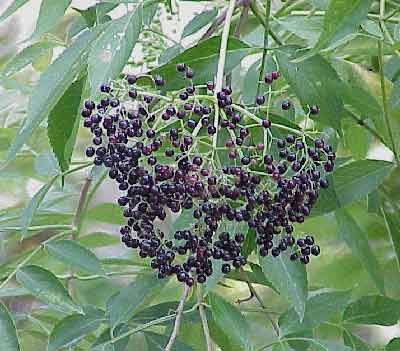
Elderberry
by Sharon LaPlante
Elderberry, Sambucus canadensis, is a medium to large shrub in the Caprifoliaceae, or honeysuckle, family. It is clonal forming and produces dense thickets when it is in its preferred habitat. It reaches a height of 15 feet at maturity and becomes tree-like in stature.
The branches are weak and tend to be arching, especially when they are heavy with fruit.
Its preferred habitat is wet hammocks, shallow ponds, stream banks, margins of swamps, and disturbed sites. It can be grown in the home landscape with a little extra watering. Don Robinson grows elderberry in the sandhills of Spring Hill and has it attain almost champion size. So don't be afraid to try it in locations other than its preferred habitat.
Its leaves are opposite and pinnately compound. The leaflets
are toothed and found in numbers of 5-9. The lower leaves may be trifoliate.
The small white flowers are born in flat topped clusters. They tend to bloom all year, but their peak blooming time seems to be summer. The flowers are edible and can be used in pancakes, fritters, and cornbread once the stems are removed.
The small black berries hang in clusters, and are eaten by birds and mammals. They are eaten by humans as well, and are used for making pies, jellies, jams, and wines. They can also be used as a substitute for raisins in bread pudding recipes. The berries should be cooked before ingesting.
Austin, Dan. Coastal Dune Plants. Gumbo Limbo Nature Center of South Palm Beach County, Inc. 1991 (illustration)
Nelson, Gil. The Shrubs & Woody Vines of Florida. Pineapple Press: Sarasota, FL 1996
Radford, Albert E., H. E. Ahles and C. R. Bell. Manual of Vascular Flora of the Carolinas. University of North Carolina: Chapel Hill, NC. 1964
Scurlock, J. Paul. Native Trees and Shrubs of the Florida Keys. Laurel & Herbert, Inc.: Sugarloaf Shores, FL. 1996
Return to the Main Page
All material on this site © Hernando Chapter of the FNPS. The materials on this website may be copied and distributed without permission, provided that it is used for non-commercial, informational or educational purposes, and you acknowledge this site and the Hernando Chapter of the Florida Native Plant Society as the source of publication.